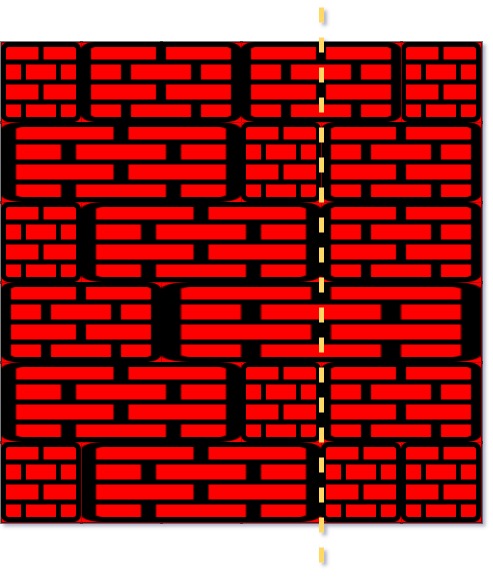英文原文
There is a rectangular brick wall in front of you with n rows of bricks. The ith row has some number of bricks each of the same height (i.e., one unit) but they can be of different widths. The total width of each row is the same.
Draw a vertical line from the top to the bottom and cross the least bricks. If your line goes through the edge of a brick, then the brick is not considered as crossed. You cannot draw a line just along one of the two vertical edges of the wall, in which case the line will obviously cross no bricks.
Given the 2D array wall that contains the information about the wall, return the minimum number of crossed bricks after drawing such a vertical line.
Example 1:

Input: wall = [[1,2,2,1],[3,1,2],[1,3,2],[2,4],[3,1,2],[1,3,1,1]] Output: 2
Example 2:
Input: wall = [[1],[1],[1]] Output: 3
Constraints:
n == wall.length1 <= n <= 1041 <= wall[i].length <= 1041 <= sum(wall[i].length) <= 2 * 104sum(wall[i])is the same for each rowi.1 <= wall[i][j] <= 231 - 1
中文题目
你的面前有一堵矩形的、由 n 行砖块组成的砖墙。这些砖块高度相同(也就是一个单位高)但是宽度不同。每一行砖块的宽度之和相等。
你现在要画一条 自顶向下 的、穿过 最少 砖块的垂线。如果你画的线只是从砖块的边缘经过,就不算穿过这块砖。你不能沿着墙的两个垂直边缘之一画线,这样显然是没有穿过一块砖的。
给你一个二维数组 wall ,该数组包含这堵墙的相关信息。其中,wall[i] 是一个代表从左至右每块砖的宽度的数组。你需要找出怎样画才能使这条线 穿过的砖块数量最少 ,并且返回 穿过的砖块数量 。
示例 1:

输入:wall = [[1,2,2,1],[3,1,2],[1,3,2],[2,4],[3,1,2],[1,3,1,1]] 输出:2
示例 2:
输入:wall = [[1],[1],[1]] 输出:3
提示:
n == wall.length1 <= n <= 1041 <= wall[i].length <= 1041 <= sum(wall[i].length) <= 2 * 104- 对于每一行
i,sum(wall[i])是相同的 1 <= wall[i][j] <= 231 - 1
通过代码
高赞题解
哈希表
题目要求穿过的砖块数量最少,等效于通过的间隙最多。
我们可以使用「哈希表」记录每个间隙的出现次数,最终统计所有行中哪些间隙出现得最多,使用「总行数」减去「间隙出现的最多次数」即是答案。
如何记录间隙呢?直接使用行前缀记录即可。
就用示例数据来举 🌰 :

- 第 1 行的间隙有
[1,3,5] - 第 2 行的间隙有
[3,4] - 第 3 行的间隙有
[1,4] - 第 4 行的间隙有
[2] - 第 5 行的间隙有
[3,4] - 第 6 行的间隙有
[1,4,5]
对间隙计数完成后,遍历「哈希表」找出出现次数最多间隙 4,根据同一个间隙编号只会在单行内被统计一次,用总行数减去出现次数,即得到「最少穿过的砖块数」。
代码(感谢 @nactran 同学提供的其他语言版本):
[]class Solution { public int leastBricks(List<List<Integer>> wall) { int n = wall.size(); Map<Integer, Integer> map = new HashMap<>(); for (int i = 0, sum = 0; i < n; i++, sum = 0) { for (int cur : wall.get(i)) { sum += cur; map.put(sum, map.getOrDefault(sum, 0) + 1); } map.remove(sum); // 不能从两边穿过,需要 remove 掉最后一个 } int ans = n; for (int u : map.keySet()) { int cnt = map.get(u); ans = Math.min(ans, n - cnt); } return ans; } }
[]class Solution { public: int leastBricks(vector<vector<int>>& wall) { int n = wall.size(); unordered_map<int,int> map; for (int i = 0, sum = 0; i < n; i++, sum = 0) { for (int cur : wall[i]) { sum += cur; map[sum]++; } map.erase(sum); // 不能从两边穿过,需要 remove 掉最后一个 } int ans = n; for (auto& [u,cnt] : map) { ans = min(ans, n - cnt); } return ans; } };
- 时间复杂度:记所有砖块数量为
n,所有砖块都会被扫描。复杂度为 $O(n)$ - 空间复杂度:$O(n)$
关于是否需要考虑「溢出」的说明
类似的问题,在之前 题解 也说过,这里再提一下 ~
当 Java 发生溢出时,会直接转成负数来处理。因此对于本题不会影响正确性(不重复溢出的话)。
可以通过以下例子来体会:
[]{ System.out.println(Integer.MIN_VALUE); // -2147483648 int a = Integer.MAX_VALUE; System.out.println(a); // 2147483647 a += 1; System.out.println(a); // -2147483648 a -= 1; System.out.println(a); //2147483647 }
这意味着,如果我们在运算过程中如果只涉及「纯加减运算」,而不涉及「乘除」、「取最大值/最小值」和「数值大小判断」的话,Java 是不需要使用 Long 来确保正确性的,因为最终溢出会被转化回来。
按道理,CPP 本身对于 int 溢出的转化处理也是一样的。
但在 LC 上的 CPP 发生溢出时,不会直接转成负数来处理,而是直接抛出异常。因此同样的代码在 LC 上是无法被正常执行的:
[]{ cout << INT_MIN << endl; //-2147483648 int a = INT_MAX; cout << a << endl; // 2147483647 a += 1; // 溢出报错 cout << a << endl; a -= 1; cout << a << endl; }
这是一般性的,对于 LC 上的同一道题,Java 不需要处理溢出,CPP 需要处理的原因。
其实对应到本题,我这里不使用 long long,是因为猜想「题目」中的条件写错了:
1 <= sum(wall[i]) <= 2 * 10^4
错写成了
1 <= sum(wall[i].length) <= 2 * 10^4因为在给定下面两个条件的情况下:
1 <= n <= 10^4
1 <= wall[i].length <= 10^4$1 <= sum(wall[i].length) <= 2 * 10^4$ 十分多余。
针对反例:
[
[2147483647,2147483647,2147483647,2147483647,1,2],
[2,2147483647,2147483647,2147483647,2147483647,1]
]我用官方提供的代码,跑的也是 0,所以如果是以官方的代码为评测标准的话,用 long long 反而是 WA 了 🤣
最后
如果有帮助到你,请给题解点个赞和收藏,让更多的人看到 ~ (“▔□▔)/
也欢迎你 关注我 和 加入我们的「组队打卡」小群 ,提供写「证明」&「思路」的高质量题解
统计信息
| 通过次数 | 提交次数 | AC比率 |
|---|---|---|
| 46914 | 93132 | 50.4% |
提交历史
| 提交时间 | 提交结果 | 执行时间 | 内存消耗 | 语言 |
|---|




